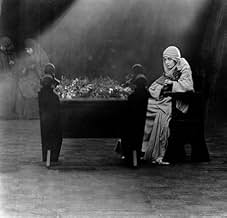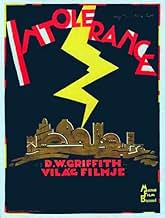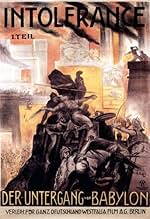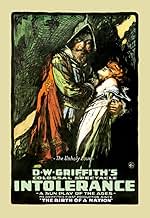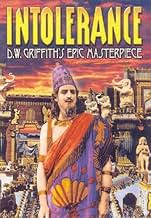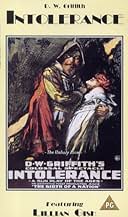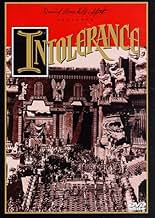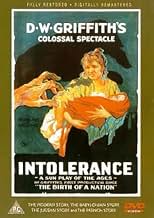Intolérance
Titre original : Intolerance: Love's Struggle Throughout the Ages
- 1916
- Tous publics
- 2h 43min
NOTE IMDb
7,7/10
18 k
MA NOTE
L'histoire d'une jeune femme pauvre, séparée de son mari et de son bébé à cause de préjugés, se mêle à d'autres récits d'intolérance issus d'autres époques.L'histoire d'une jeune femme pauvre, séparée de son mari et de son bébé à cause de préjugés, se mêle à d'autres récits d'intolérance issus d'autres époques.L'histoire d'une jeune femme pauvre, séparée de son mari et de son bébé à cause de préjugés, se mêle à d'autres récits d'intolérance issus d'autres époques.
- Réalisation
- Scénario
- Casting principal
- Récompenses
- 2 victoires au total
F.A. Turner
- The Dear One's Father
- (as Fred Turner)
Julia Mackley
- Uplifter
- (as Mrs. Arthur Mackley)
John P. McCarthy
- Prison Guard
- (as J.P. McCarthy)
Avis à la une
I saw a four hour, ten minute version of this as the University of Chicago's Ida Noyes Hall in February, 1993 -- restored with stills and copyright photos, with a new score by Gillian Anderson, featuring the composer conducting the University Symphony Orchestra -- what an experience!
And where, oh where, is this restored version to be seen today?
Somebody get on the copyright owner's case to release the 4:10 version, with Gillian Anderson's score!
This fine film, possibly the quintessential Griffith, has been in the shadow of the notorious Birth of a Nation too long. (Of course, without Birth of a Nation's controversy, this might never have been made). Intolerance has more spectacle than Birth, far more "speaking" parts (if that's not an oxymoron, I don't know what is!), and is far more PC -- but not in a negative way.
See it, in any form you can!
And where, oh where, is this restored version to be seen today?
Somebody get on the copyright owner's case to release the 4:10 version, with Gillian Anderson's score!
This fine film, possibly the quintessential Griffith, has been in the shadow of the notorious Birth of a Nation too long. (Of course, without Birth of a Nation's controversy, this might never have been made). Intolerance has more spectacle than Birth, far more "speaking" parts (if that's not an oxymoron, I don't know what is!), and is far more PC -- but not in a negative way.
See it, in any form you can!
I first saw this picture as a teenager some thirty years ago. I had no idea what to expect; all I knew was the famous still of Belshazzar's feast which has become one of the best known icons depicting the extravagance of crazy old Hollywood. But I was astounded and bowled over by what I saw. I will make no attempt at a plot synopsis here, since several other reviewers on this site have done so. Most readers already know that Griffith set out to tell four separate stories, laid in four widely spaced historical periods, and that he intercut freely between them, increasing the tempo as the film proceeded, and attempted to bring all four to a climax simultaneously. Clearly he bit off more than he, or anybody, could chew; but the fact that the limits of what cinema could do were being pushed so hard so early is what fascinated me then, and still fascinates me now. I wish to heaven that college film courses would just blow off "Birth of a Nation" and consign it to the oblivion it largely deserves, and show "Intolerance" instead, for this indeed is Griffith's monument, despite its poor state of repair; and at the risk of being technical I would like to address this. I have noticed that the one negative comment running most consistently through the reviews posted on this website is the relative lack of weight given to the French and Judaean sequences relative to the Modern and Babylonian narratives. This is largely the fault of the movie's checkered preservation history. When "Intolerance" failed to make huge sums at the box office, Griffith released the Babylonian and Modern stories as individual features in 1919, reshooting some scenes along the way. He cut up the original negative (gasp!) to do this, and by the time he decided to reassemble the whole movie in 1926, it turned out that all the king's horses and all the king's men couldn't quite put Humpty Dumpty back together again. There was never a shooting script, or a written continuity; Griffith kept the whole thing in his head, and moreover could never stop tinkering with it while it was in release! Consequently, while the Babylonian and Modern stories have survived largely intact, the French and Judaean episodes were depleted by about half. So when we see it now we must recognize that we are viewing a broken sculpture. The movie is a restorer's nightmare; almost a third of its 2000- plus shots exist in variant versions, and the captions were rewritten more than once. But, broken as it is, it's still magnificent. There has never been, and will never again be, anything like it. It has all of Griffith's inconsistencies: subtle and naturalistic acting from Mae Marsh and Robert Harron as the luckless couple in the Modern Story are seen cheek by jowl with outrageous mugging by Walter Long as the Musketeer of the Slums, or Josephine Crowell's Catherine de Medici in France; but no masterpiece on this scale is ever consistent, after all. I love Connie Talmadge's Mountain Girl from Babylon; smart, funny and crazy. Other favorites: Tully Marshall as the villainous Priest of Bel; Seena Owen as the Princess beloved, my personal nomination for Most Fabulous Body of the Hollywood 1910s, never mind the deranged costumes; Alfred Paget as a genuinely humane Belshazzar; Howard Gaye as a believable and totally unforced Jesus. Everything the silent screen of 1916 could do, good, bad, subtle, overblown, crazy or glorious is embodied here; and Griffith never rode so high again. The most satisfactory version currently available, in my opinion, is the Kino on Video edition on vhs and dvd, the one illustrated when you first call the picture up on this site. There are some problems and a few missing bits that I take exception to, but overall this is the version that first time viewers should try.
This mammoth production and DW Griffith's 1916 masterpiece was his followup to The Birth of a Nation. Intolerance blends 4 stories of historical intolerance as a warning against the current-day evils of war. The French and Judean stories are OK. The Babylonian and Modern stories are spectacular. Where Griffith experimented with closeups and intercutting stories in Birth of a Nation, these techniques are mastered in Intolerance. Griffith also continues his incredible eye for composition and scenery and costumes in this epic film.
The sets and costumes for the Babylonian story are among the best in film history. And the battle scenes equal anything in Birth of a Nation. Griffith's Babylonian set is so huge it allows for horse-drawn chariots to ride side by side on the road at the top of the towering walls. The camera shot that shows the chariots and the battle many stories below is astounding. There is also the famous camera shot that slowly moves closer and closer the the city steps and gates where hundreds of dancers perform a pagan production number. Just amazing.
The emotional oomph of this film comes from the modern story where a young couple living in a tenement apartment almost gets destroyed by society do-gooders. The intercutting of scenes here is masterful as the rescuers race to save the hero who is about to be hanged. Melodrama to be sure, but in a form never seen before 1916.
And as usual Griffith assembles a terrific cast and elicits great performances from many of them.
Constance Talmadge plays the cinema's first feminist heroine as the Mountain Girl in the Babylonian story. She's wonderful as the saucy girl who eats onions while on the block to be sold as a slave. As the men come near to examine her (she's dressed in a pelt) she shakes her onions at them and kicks at them. Hilarious. The story is complicated but she overhears a plot to attack the city and the ruler (who set her free) she adores. Great scenes of Talmadge racing a chariot through the desert. Great battle scenes that are unforgettable. Great orgy scenes. This is just a wonderful story that is so eye-filling, you have to watch it several times to take everything in.
The modern story boasts a perfect performance by Mae Marsh as the "Dear One." Robert Harron is the husband, and Miriam Cooper (very underrated) is the "bad girl." One of the most harrowing scenes I can remember is when the "do-gooders" (headed by Vera Lewis) come to take Marsh's baby after Harron is falsely arrest for murder. Marsh is so realistic in this frenzied scene that your heart just stops. Harron is also excellent as the hapless boy who gets framed for murder. The editing of this arc of the film sets the standard for decades to come.
Intolerance must be seen by any serious film buff. It's a long film but is unforgettable. The cast list is impressive and includes the above-mentioned Constance Talmadge, Mae Marsh, Robert Harron, Miriam Cooper, Lillian Gish, Vera Lewis, Ralph Lewis, Douglas Fairbanks, Bessie Love, Wallace Reid, Elmo Lincoln, Elmer Clifton, Mary Alden, Constance Collier, Carmel Myers, Erich von Stroheim, Donald Crisp, Carol Dempster, Marguerite Marsh, Tully Marshall, Natalie Talmadge, Alma Rubens, Seena Owen, Margery Wilson, Eugene Palette, Ethel Grey Terry, Owen Moore, Alfred Paget, Joseph Henabery, Josephine Crowell, Ruth St. Denis, Ted Shawn, Mildred Harris, Walter Long, Sam De Grasse, Monte Blue, Kate Bruce, Nigel De Brulier, Pauline Starke, Lillian Langdon, and future directors King Vidor, Frank Borzage, and Tod Browning!
The sets and costumes for the Babylonian story are among the best in film history. And the battle scenes equal anything in Birth of a Nation. Griffith's Babylonian set is so huge it allows for horse-drawn chariots to ride side by side on the road at the top of the towering walls. The camera shot that shows the chariots and the battle many stories below is astounding. There is also the famous camera shot that slowly moves closer and closer the the city steps and gates where hundreds of dancers perform a pagan production number. Just amazing.
The emotional oomph of this film comes from the modern story where a young couple living in a tenement apartment almost gets destroyed by society do-gooders. The intercutting of scenes here is masterful as the rescuers race to save the hero who is about to be hanged. Melodrama to be sure, but in a form never seen before 1916.
And as usual Griffith assembles a terrific cast and elicits great performances from many of them.
Constance Talmadge plays the cinema's first feminist heroine as the Mountain Girl in the Babylonian story. She's wonderful as the saucy girl who eats onions while on the block to be sold as a slave. As the men come near to examine her (she's dressed in a pelt) she shakes her onions at them and kicks at them. Hilarious. The story is complicated but she overhears a plot to attack the city and the ruler (who set her free) she adores. Great scenes of Talmadge racing a chariot through the desert. Great battle scenes that are unforgettable. Great orgy scenes. This is just a wonderful story that is so eye-filling, you have to watch it several times to take everything in.
The modern story boasts a perfect performance by Mae Marsh as the "Dear One." Robert Harron is the husband, and Miriam Cooper (very underrated) is the "bad girl." One of the most harrowing scenes I can remember is when the "do-gooders" (headed by Vera Lewis) come to take Marsh's baby after Harron is falsely arrest for murder. Marsh is so realistic in this frenzied scene that your heart just stops. Harron is also excellent as the hapless boy who gets framed for murder. The editing of this arc of the film sets the standard for decades to come.
Intolerance must be seen by any serious film buff. It's a long film but is unforgettable. The cast list is impressive and includes the above-mentioned Constance Talmadge, Mae Marsh, Robert Harron, Miriam Cooper, Lillian Gish, Vera Lewis, Ralph Lewis, Douglas Fairbanks, Bessie Love, Wallace Reid, Elmo Lincoln, Elmer Clifton, Mary Alden, Constance Collier, Carmel Myers, Erich von Stroheim, Donald Crisp, Carol Dempster, Marguerite Marsh, Tully Marshall, Natalie Talmadge, Alma Rubens, Seena Owen, Margery Wilson, Eugene Palette, Ethel Grey Terry, Owen Moore, Alfred Paget, Joseph Henabery, Josephine Crowell, Ruth St. Denis, Ted Shawn, Mildred Harris, Walter Long, Sam De Grasse, Monte Blue, Kate Bruce, Nigel De Brulier, Pauline Starke, Lillian Langdon, and future directors King Vidor, Frank Borzage, and Tod Browning!
"Intolerance" is D.W. Griffith's apologia for "The Birth of a Nation" mostly in that it surpasses its predecessor's epic scale, thus replying to his critics. "The Birth of a Nation" was a racist film, and nothing in "Intolerance" proves otherwise, but I don't think that's the point, either. And, while Griffith calls his critics hypocrites, it's just as easy to call Griffith one for his racism. Yet, I have no disagreement that his films are art despite their messages. "Intolerance" contains much more agreeable views than "The Birth of a Nation", anyhow: Christian pacifism; support of labor; moderated progressivism; and condemnation of intolerance, hatred and inhumanity throughout the ages.
The narrative structure of "Intolerance" was revolutionary and particularly surprising for a filmmaker who had cemented in cinema a traditional and theatrical form of linear storytelling with his previous work. In "Home, Sweet Home" (1914), Griffith linked four separate stories with a single theme, but with each story told in full before proceeding to the next. With "Intolerance", he employed parallel editing, thus continually crosscutting between time, suspending plots and commenting on stories with other stories, and I think it's ingeniously congruent considering the stories are supposed to run parallel in their morals, or messages on the general theme of intolerance.
The four stories include a modern story, which features a fictional representation of the Ludlow massacre of strikers and a progressive era foundation of busybody reformers that indirectly causes the massacre and directly applies suffering on the central characters. It was originally intended as a complete film in itself and was later released as such under the title "The Mother and the Law". Then, there's the Babylonian story, which was also released by itself, as "The Fall of Babylon". It almost seems to be more likely to have been directed by Cecil B. DeMille than by D.W. Griffith, for all its sex and exotic set design against a historical setting. A contemporary of Griffith, however, DeMille had not yet figured out that formula and may well have been thinking of the Babylonian sequences in "Intolerance" when he did; one of his early pictures and first attempts at an epic, "Joan the Woman" (1917), does demonstrate Griffith's influence on him. Additionally, the sequence features the best performance in the film by ingénue Constance Talmadge as the "Mountain Girl". She, too, seems out of place in a Griffith production, with her sexuality, impropriety and independence. The lesser stories of Christ's life and his crucifixion and the events leading up to the St. Bartholomew's Day Massacre aren't especially interesting in themselves, as many have panned. Yet, I don't think that's essential, as they don't stand by themselves, but are part of a whole where they comment on and run parallel to each other and the other narratives.
The stories are connected by explanatory, as well as moralizing and poetical, intertitles and by glimpses of Lillian Gish endlessly rocking the cradle (taken from Walt Whitman). Reportedly, tinting also separated the stories upon initial release. Nearing the climax, however, these separations and transitions evaporate for an ever more merging and rapider plot. "Intolerance" is the apex of Griffith's innovations and developments in editing--the culmination of his achievements in "The Birth of a Nation" and his last-minute-rescue pictures and other Biograph shorts. Along the way, it was usually James and Rose Smith who aided him in the editing room. Doubtless, these achievements, especially in "Intolerance", greatly influenced the Soviet and European montage filmmakers, as well as subsequent filmmaking in general.
With the astounding success of "The Birth of a Nation", Griffith had the opportunity to make almost any film he wanted, and with "Intolerance" having cost nearly $400,000 to make, he did. (The some $100,000 budget for "The Birth of a Nation" had been unheard of in Hollywood.) The film's failure financially ruined Triangle Studios and considerably altered and limited Griffith's filmmaking career from thereon. As "The Birth of a Nation" demonstrated to Hollywood and the world how profitable and popular cinema could be, "Intolerance" told another important lesson on the risks and limitations involved.
Consuming much of the film's budget were Walter L. Hall's Babylon sets, and they are spectacular. They're also surprisingly imaginative and elaborate for D.W. Griffith, whose stagy, open-air sets in previous productions were generally unremarkable--besides those in "Judith of Bethulia" (1914), which pale in comparison. The influence of "Cabiria" (1914) is very evident, but where that film failed to equal the brilliance of its sets with the filming of them, "Intolerance" succeeds. The legendary crane shots are standouts.
Throughout the film, cinematographer "Billy" Bitzer masks the camera lens--more extensively than ever before--creating iris shots, a moving iris shot within a stationary shot and small-scale widescreen effects. Griffith and Bitzer are very much in control of the images, establishing us as spectators. The Babylonian scenes where characters look down at miniatures of the city, I think, also add to this emphasis. And, "Intolerance" is quite a spectacle, especially the Babylonian scenes. Overall, the cinematography, such as some extreme close-ups, is innovative and advanced. Additionally, Griffith and Bitzer once again proved themselves masters of filming battle scenes.
"Cabiria" and the other Italian epics were a great impetus for Griffith to have embarked on his own two epic masterpieces, but the Italian epics were merely super-theatrical, with "Cabiria" as its apex and somewhat of a bridge to Griffith making the epic a cinematic art and a cornerstone of the industry. Moreover, from his pioneering short films at Biograph, to the epics "The Birth of a Nation" and "Intolerance", and to a lesser extent, his work thereafter, nobody has had a greater influence on the course cinema would take than D.W. Griffith.
The narrative structure of "Intolerance" was revolutionary and particularly surprising for a filmmaker who had cemented in cinema a traditional and theatrical form of linear storytelling with his previous work. In "Home, Sweet Home" (1914), Griffith linked four separate stories with a single theme, but with each story told in full before proceeding to the next. With "Intolerance", he employed parallel editing, thus continually crosscutting between time, suspending plots and commenting on stories with other stories, and I think it's ingeniously congruent considering the stories are supposed to run parallel in their morals, or messages on the general theme of intolerance.
The four stories include a modern story, which features a fictional representation of the Ludlow massacre of strikers and a progressive era foundation of busybody reformers that indirectly causes the massacre and directly applies suffering on the central characters. It was originally intended as a complete film in itself and was later released as such under the title "The Mother and the Law". Then, there's the Babylonian story, which was also released by itself, as "The Fall of Babylon". It almost seems to be more likely to have been directed by Cecil B. DeMille than by D.W. Griffith, for all its sex and exotic set design against a historical setting. A contemporary of Griffith, however, DeMille had not yet figured out that formula and may well have been thinking of the Babylonian sequences in "Intolerance" when he did; one of his early pictures and first attempts at an epic, "Joan the Woman" (1917), does demonstrate Griffith's influence on him. Additionally, the sequence features the best performance in the film by ingénue Constance Talmadge as the "Mountain Girl". She, too, seems out of place in a Griffith production, with her sexuality, impropriety and independence. The lesser stories of Christ's life and his crucifixion and the events leading up to the St. Bartholomew's Day Massacre aren't especially interesting in themselves, as many have panned. Yet, I don't think that's essential, as they don't stand by themselves, but are part of a whole where they comment on and run parallel to each other and the other narratives.
The stories are connected by explanatory, as well as moralizing and poetical, intertitles and by glimpses of Lillian Gish endlessly rocking the cradle (taken from Walt Whitman). Reportedly, tinting also separated the stories upon initial release. Nearing the climax, however, these separations and transitions evaporate for an ever more merging and rapider plot. "Intolerance" is the apex of Griffith's innovations and developments in editing--the culmination of his achievements in "The Birth of a Nation" and his last-minute-rescue pictures and other Biograph shorts. Along the way, it was usually James and Rose Smith who aided him in the editing room. Doubtless, these achievements, especially in "Intolerance", greatly influenced the Soviet and European montage filmmakers, as well as subsequent filmmaking in general.
With the astounding success of "The Birth of a Nation", Griffith had the opportunity to make almost any film he wanted, and with "Intolerance" having cost nearly $400,000 to make, he did. (The some $100,000 budget for "The Birth of a Nation" had been unheard of in Hollywood.) The film's failure financially ruined Triangle Studios and considerably altered and limited Griffith's filmmaking career from thereon. As "The Birth of a Nation" demonstrated to Hollywood and the world how profitable and popular cinema could be, "Intolerance" told another important lesson on the risks and limitations involved.
Consuming much of the film's budget were Walter L. Hall's Babylon sets, and they are spectacular. They're also surprisingly imaginative and elaborate for D.W. Griffith, whose stagy, open-air sets in previous productions were generally unremarkable--besides those in "Judith of Bethulia" (1914), which pale in comparison. The influence of "Cabiria" (1914) is very evident, but where that film failed to equal the brilliance of its sets with the filming of them, "Intolerance" succeeds. The legendary crane shots are standouts.
Throughout the film, cinematographer "Billy" Bitzer masks the camera lens--more extensively than ever before--creating iris shots, a moving iris shot within a stationary shot and small-scale widescreen effects. Griffith and Bitzer are very much in control of the images, establishing us as spectators. The Babylonian scenes where characters look down at miniatures of the city, I think, also add to this emphasis. And, "Intolerance" is quite a spectacle, especially the Babylonian scenes. Overall, the cinematography, such as some extreme close-ups, is innovative and advanced. Additionally, Griffith and Bitzer once again proved themselves masters of filming battle scenes.
"Cabiria" and the other Italian epics were a great impetus for Griffith to have embarked on his own two epic masterpieces, but the Italian epics were merely super-theatrical, with "Cabiria" as its apex and somewhat of a bridge to Griffith making the epic a cinematic art and a cornerstone of the industry. Moreover, from his pioneering short films at Biograph, to the epics "The Birth of a Nation" and "Intolerance", and to a lesser extent, his work thereafter, nobody has had a greater influence on the course cinema would take than D.W. Griffith.
Everything about this movie is fascinating, even its numerous flaws. It is as ambitious a movie as has ever been made, and if you adjust for the era, it might also be the most lavish, expensive, and painstaking. Even today the scope and detail stand out, despite the many technical limitations in its era. Likewise, the enormous cast list contains many names that silent film fans will recognize at once, with well-known performers even in some of the minor roles. Then, you could write many pages about the stories, which are filled with weaknesses, but which are also so interesting that you never want to miss what will happen next.
The concept behind "Intolerance" is as enterprising as it gets: no fewer than four complete, independent story-lines, with the movie switching back-and-forth among them, not necessarily in consecutive order but with a definite plan in mind, all in order to get across the idea suggested by the title - that is, that intolerance of others' beliefs or lifestyles has been a destructive force throughout history. It is generally understood that there is a strong dose of defensiveness behind this plan, since the ideas promoted in Griffith's previous film had earned for him some severe and well-justified criticism. This personal motivation could well explain why "Intolerance" is often so overblown, and it also is interesting in light of the stories chosen to illustrate the main themes.
The two most straightforward stories - the persecution of the Huguenots in 16th century France, and the persecution of Jesus Christ by the religious leaders of his day - are also the most believable, and yet they do not seem to get quite the screen time or the lavish detail of the other two. The contemporary story may have been the most important to Griffith, and it is a full-scale melodrama, full of heavy-handed developments and very unlikely coincidences, yet certainly a story that will hold your attention. The Babylonian story is at once the strangest choice, the most extravagant, and the most fascinating of all. As history, it is as distorted as (or more so than) any of today's movies. Trying to pass off Belshazzar of Babylon as a model of justice and tolerance is just weird, and the entire historical scenario is at best an imaginative embellishment of the truth. But the involved story that Griffith tells in this setting is so exciting and entertaining that you just can't take your eyes away from it.
Much, much more could be said, but anyone with an interest in silent movies or in cinema history will want to watch it and draw his or her own conclusions. Whether you want to analyze the vast array of themes, events, and ideas, or whether you just want to sit back and enjoy a fascinating spectacle, the three hours fly by very quickly, and it's a movie you won't forget.
The concept behind "Intolerance" is as enterprising as it gets: no fewer than four complete, independent story-lines, with the movie switching back-and-forth among them, not necessarily in consecutive order but with a definite plan in mind, all in order to get across the idea suggested by the title - that is, that intolerance of others' beliefs or lifestyles has been a destructive force throughout history. It is generally understood that there is a strong dose of defensiveness behind this plan, since the ideas promoted in Griffith's previous film had earned for him some severe and well-justified criticism. This personal motivation could well explain why "Intolerance" is often so overblown, and it also is interesting in light of the stories chosen to illustrate the main themes.
The two most straightforward stories - the persecution of the Huguenots in 16th century France, and the persecution of Jesus Christ by the religious leaders of his day - are also the most believable, and yet they do not seem to get quite the screen time or the lavish detail of the other two. The contemporary story may have been the most important to Griffith, and it is a full-scale melodrama, full of heavy-handed developments and very unlikely coincidences, yet certainly a story that will hold your attention. The Babylonian story is at once the strangest choice, the most extravagant, and the most fascinating of all. As history, it is as distorted as (or more so than) any of today's movies. Trying to pass off Belshazzar of Babylon as a model of justice and tolerance is just weird, and the entire historical scenario is at best an imaginative embellishment of the truth. But the involved story that Griffith tells in this setting is so exciting and entertaining that you just can't take your eyes away from it.
Much, much more could be said, but anyone with an interest in silent movies or in cinema history will want to watch it and draw his or her own conclusions. Whether you want to analyze the vast array of themes, events, and ideas, or whether you just want to sit back and enjoy a fascinating spectacle, the three hours fly by very quickly, and it's a movie you won't forget.
Le saviez-vous
- AnecdotesDuring filming of the battle sequences, many of the extras got so into their characters that they caused real injury to one another. At the end of one shooting day, a total of 60 injuries were treated at the production's hospital tent.
- GaffesOne of the early title cards in the Judean sequence refers to Jesus having been from "the carpenter shop in Bethlehem". Though he was born in Bethlehem, he worked with his father in a carpenter shop in Nazareth, which is why he was known as Jesus of Nazareth.
- Citations
Intertitle: When women cease to attract men, they often turn to reform as a second option.
- Crédits fousConstance Talmadge is credited as 'Georgia Pearce' for her performance as Marguerite de Valois in the French Story. She is credited under her own name in the role of The Mountain Girl in the Babylonian Story.
- Versions alternativesThe movie was officially restored in 1989 by Kevin Brownlow and David Gill for Thames Television. It was transferred from the best available 35mm materials, color-tinted per D.W. Griffith's intent, and contains a digitally recorded orchestral score by Carl Davis. This 176-minute version was released on video worldwide, but has never been telecast in the U.S.
- ConnexionsEdited into La Chute de Babylone (1919)
Meilleurs choix
Connectez-vous pour évaluer et suivre la liste de favoris afin de recevoir des recommandations personnalisées
- How long is Intolerance?Alimenté par Alexa
Détails
Box-office
- Budget
- 385 907 $US (estimé)
- Durée2 heures 43 minutes
- Mixage
- Rapport de forme
- 1.33 : 1
Contribuer à cette page
Suggérer une modification ou ajouter du contenu manquant

Lacune principale
By what name was Intolérance (1916) officially released in Canada in French?
Répondre

